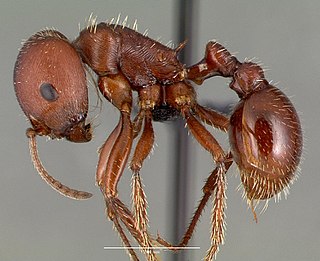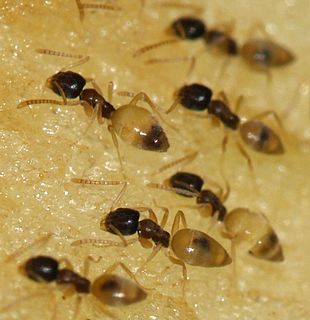
The Formicinae are a subfamily within the Formicidae containing ants of moderate evolutionary development.

Pogonomyrmex is a genus of harvester ants, occurring primarily in the deserts of North, Central, and South America, with a single endemic species from Haiti.

Dorylus, also known as driver ants, safari ants, or siafu, is a large genus of army ants found primarily in central and east Africa, although the range also extends to southern Africa and tropical Asia. The term siafu is a loanword from Swahili, and is one of numerous similar words from regional Bantu languages used by indigenous peoples to describe various species of these ants. Unlike the New World members of the former subfamily Ecitoninae, members of this genus do form temporary anthills lasting from a few days up to three months. Each colony can contain over 20 million individuals. As with their New World counterparts, there is a soldier class among the workers, which is larger, with a very large head and pincer-like mandibles. They are capable of stinging, but very rarely do so, relying instead on their powerful shearing jaws.

Tapinoma is a genus of ants that belongs to the subfamily Dolichoderinae. The genus currently comprises 74 described species distributed worldwide in tropical and temperate regions. Members of are generalized foragers, nesting in a wide variety of habitats, ranging from grasslands, open fields, woodlands, to inside buildings. The majority of species nest in the ground under objects such as stones or tree logs, other species build nests under bark of logs and stumps, in plant cavities, insect galls or refuse piles.

Cephalotes is a Neotropical genus of tree-dwelling ant species, commonly known as turtle ants. All appear to be gliding ants, with the ability to "parachute" and steer their fall so as to land back on the tree trunk rather than fall to the ground, which is often flooded.

Aphaenogaster is a genus of myrmicine ants. About 200 species have been described, including 18 fossil species. They occur worldwide except in South America south of Colombia, Sub-Saharan Africa, and Antarctica.

Crematogaster is an ecologically diverse genus of ants found worldwide, which are characterised by a distinctive heart-shaped gaster (abdomen), which gives them one of their common names, the Saint Valentine ant. Members of this genus are also known as cocktail ants because of their habit of raising their abdomens when alarmed. Most species are arboreal. These ants are sometimes known as acrobat ants.

Pseudomyrmex is a genus of stinging, wasp-like ants in the subfamily Pseudomyrmecinae. They are large-eyed, slender ants, found mainly in tropical and subtropical regions of the New World.

Tetramorium is a genus of ants in the subfamily Myrmicinae that includes more than 520 species.

Aenictus is a large army ant genus distributed in the Old World tropics and subtropics. It contains about 181 species, making it one of the larger ant genera of the world.

Plectroctena is an Afrotropical genus of ants, with most species occurring in the rainforest zones of West and Central Africa. Some species are cryptic or subterranean foragers, while others forage in open grassland terrain. The workers forage singly or in groups of 2 to 3. They nest in the earth at varying depths, or in collapsed logs. They prey mainly on millipedes, including their young or eggs.

Myrmicocrypta is a Neotropical genus of fungus-growing ants in the subfamily Myrmicinae. The genus is known from Mexico to Argentina. Their colonies are generally small, consisting of fewer than 200 individuals.

Dolichoderus is a genus of ants found worldwide.

Technomyrmex is a genus of ants in the subfamily Dolichoderinae. With 98 species, it is one of the largest and most diverse ant genera in the Dolichoderinae. The genus distributed throughout the tropical and subtropical zones with most species occurring in the Oriental-Malesian and Afrotropical regions. One species, Technomyrmex albipes is a tramp ant now widespread throughout the tropics due to human activities.

Discothyrea is a genus of small ants in the subfamily Proceratiinae. The genus is distributed in the tropics and subtropics throughout the world, where they usually nest in rotten wood, in the leaf litter, or under stones. Little is known about their biology, but ants in this genus are thought to be specialist predators of arthropod eggs and have been observed storing eggs in their nests.

Cataulacus is a genus of ants in the subfamily Myrmicinae. The genus is distributed in the Paleotropical regions, mainly in the Afrotropics. Most species are found in forests, but a few are known from more open and arid habitats.

Nesomyrmex is a genus of ants in the subfamily Myrmicinae. The genus is distributed in the Neotropical, Afrotropical and Malagasy regions. Most species live in arid climates, but some are known from the rainforest. They nest in soil or in trees. Little is known about their biology.

Dicroaspis is an African genus of ants in the subfamily Myrmicinae.

Carebara is a genus of ants in the subfamily Myrmicinae. It is one of the largest myrmicine genera with more than 174 species distributed worldwide in the tropics and the Afrotropical region. Many of them are very tiny cryptic soil and leaf litter inhabitants. They nest in rotten wood to which the bark is still adherent in the Afrotropical region, or may be lestobiotic nesting near other ant species. Some species are known to exist parasitically within termite nests. Little is known about the biology of the species. However, they are notable for the vast difference in size between queens and workers.

Lepisiota is an Old World genus of ants in the subfamily Formicinae. They nest in rotten wood, in standing trees or in the ground, generally in less forested areas.




















